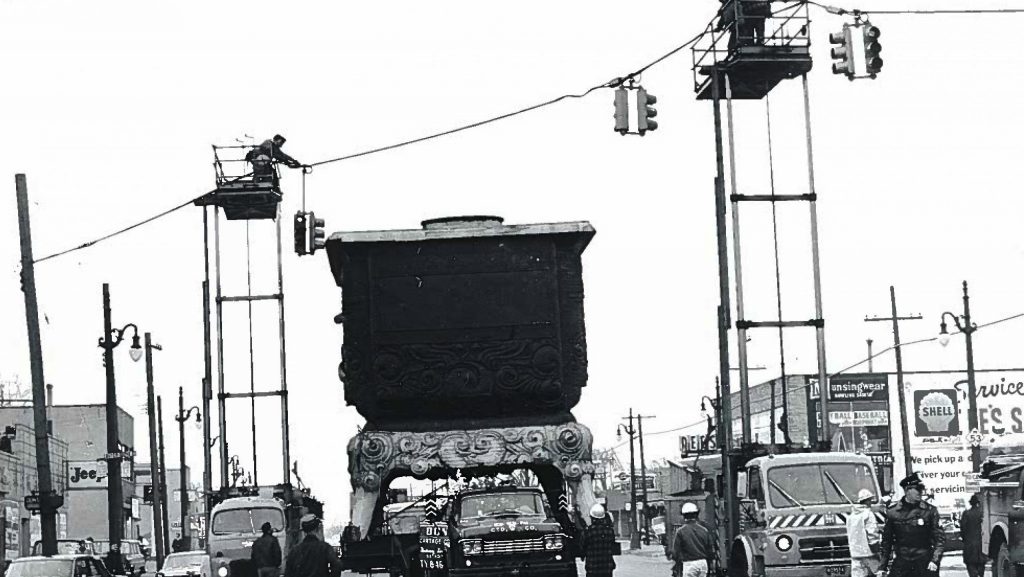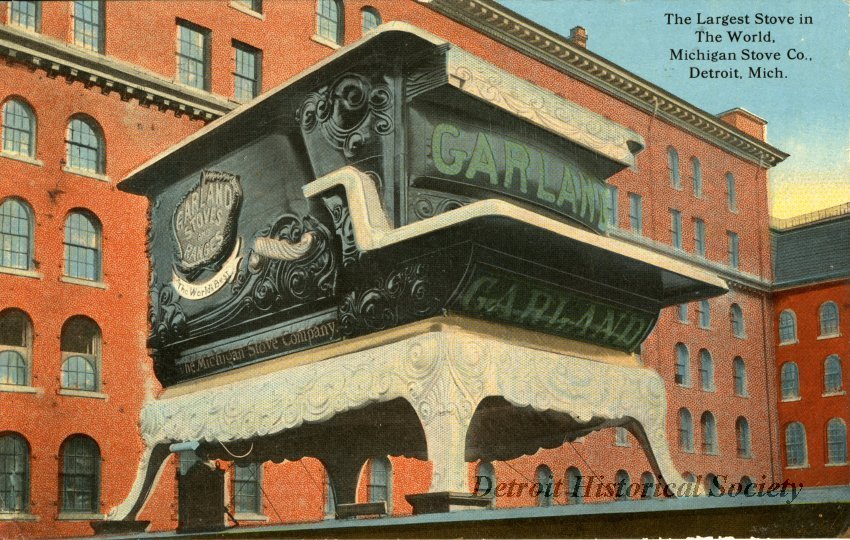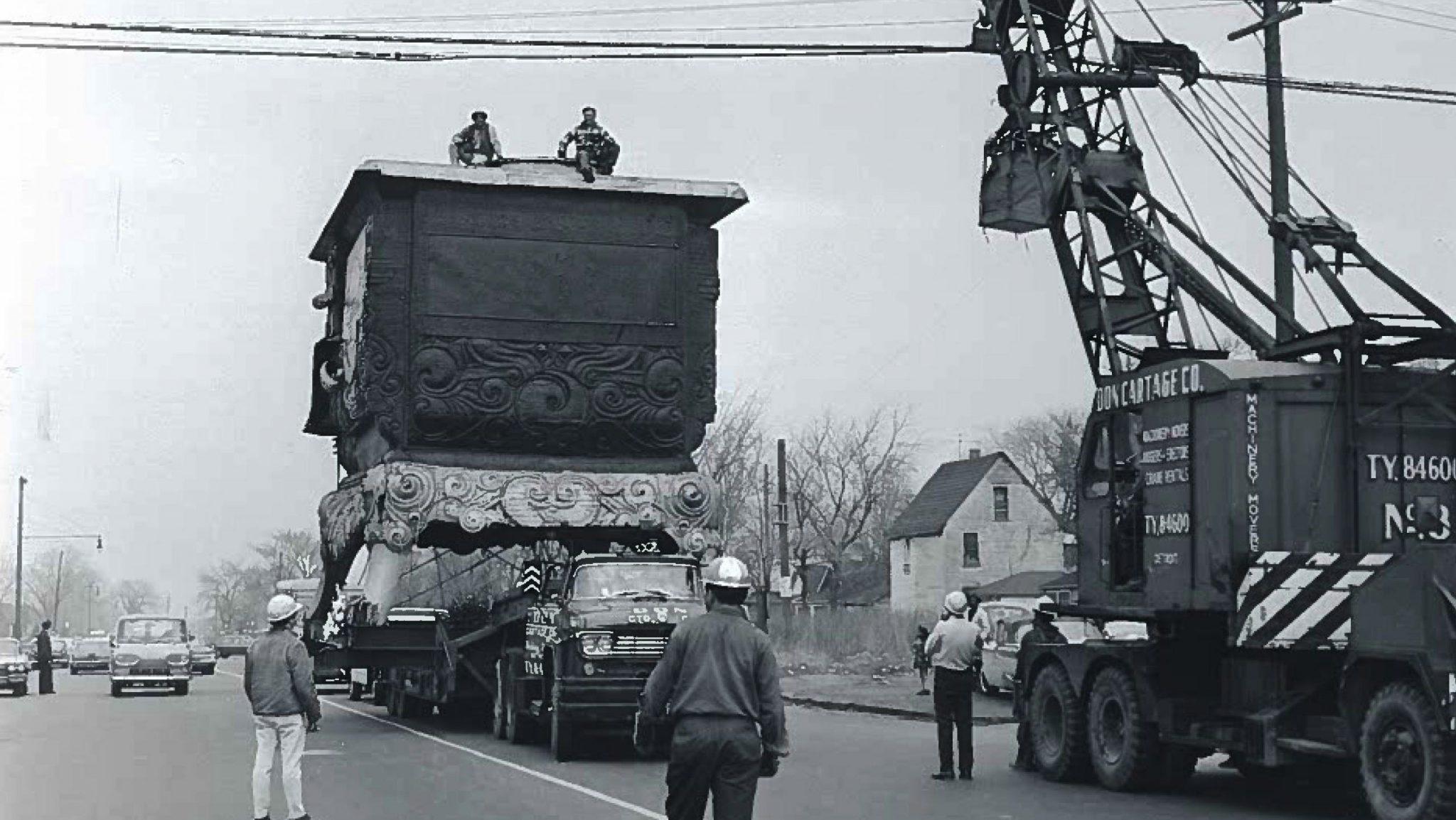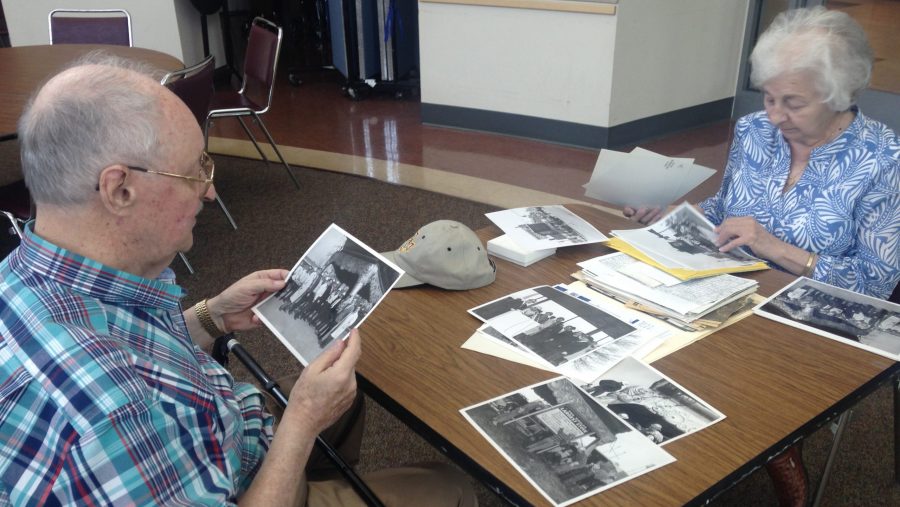CuriosiD: What happened to the ‘World’s Largest Stove’ in Detroit?
Laura Herberg December 14, 2023In this episode, we explore Detroit’s legacy as ‘The Stove Capital of the World.”

In 1965, the Don Cartage Moving Co. carefully transported the stove from across from the Belle Isle bridge to the Michigan State Fairgrounds.
WDET’s CuriosiD series answers your questions about everything Detroit. Subscribe to CuriosiD on Apple Podcasts, Spotify, NPR.org or wherever you get your podcasts.
In this episode of CuriosiD, we answer the question:
“What happened to Detroit’s ‘World’s Largest Stove’?”
The Short Answer
Before Michigan was known for making cars, it was known for manufacturing stoves. As part of that legacy, the City of Detroit became host to “The World’s Largest Stove.” Despite the name, the monument wasn’t an actual stove but was a 25-foot-tall wooden replica of a Garland stove produced by the Michigan Stove Company for the World’s Columbian Exposition in Chicago. Throughout its lifetime the giant stove was displayed at multiple locations in Detroit including at the Michigan State Fairgrounds for a total of almost two decades. On more than one occasion the stove almost met its demise. In the end it went up in flames after reportedly being struck by lightning in 2011. To this day, portions of its charred remains are stored in a Detroit Historical Society warehouse at Historic Fort Wayne in Detroit.
The story of the ‘World’s Largest Stove’
In 1993, John Hertel was called on to manage the Michigan State Fair.
“So here I was running the fair and one of the big problems of the fair was all of the history of America’s oldest state fair was missing,” Hertel told WDET’s Laura Herberg in 2016. “And one day early on somebody brought this little tin box — that you used to keep addresses in, that was rusty and filled with old cards — to my office and I said ‘Just set it over there.’ We were busy with bigger things.
“I can remember it sat there for weeks if not months and finally one day when it was raining and there was not much you could do at the fairgrounds I went over and opened the box and started going through the cards,” Hertel said. “And one of the old cards had on it just the words in pencil ‘The Stove’ along with a phone number.”
Hertel called the number and a woman answered. She told him he had reached the Detroit Historical Museum’s warehouse.
“And I said, ‘Do you have the giant stove there?’ And she said, ‘Well, unfortunately we do but it’s in piles of rubble.’

“The Stove Capital of the World”
Before Motown, before cars, before Coneys — Detroit was known for stoves. So, how did that happen?
Up until the Civil War, most people were cooking dinner in fireplaces. That was inefficient.
“All the heat went up the chimney,” Bill Loomis, a Detroit-based history writer told Herberg in 2016. “And they were also very messy and hard to cook and there was limited things you could do. So the stove came about as a replacement for that.”
Once stoves were introduced, everybody wanted one.
“Stoves were really the very first durable goods ‘gotta have it’ thing for the house,” said Loomis.
They were a hot commodity, you could say. This was good for Michigan because the state was especially equipped for their production.
At the time stoves were built by “taking molten iron out of a furnace and pouring it into a mold in sand that was then cooled and became a part of a box of the stove,” said Loomis.
Michigan had iron ore deposits up north and access to coal — which it used to melt the iron — to the south. The state quickly became a hot bed for the industry.
One of the manufacturers was the Michigan Stove Company, which produced the Garland brand. The company wanted to show off their products at the World’s Columbian Exposition in Chicago in 1893, and decided to construct “The World’s Largest Stove” to stand out.
It stood 25-feet-high and was as long and wide as most studio apartments today. The stove weighed 15 tons and was shaped more like an old-fashioned carriage than the silhouette of a modern stove. It sported a Garland label and included decorative embellishments that were common to stoves at the time. But this particular model was constructed out of what may seem like an unlikely material for a stove: wood.
“The stove companies had lots of wood carvers who would carve molds or they would carve models of the stove so the company management could look at the stove to see if they actually wanted to cast it and go into production with it,” explained Loomis.
What the Michigan Stove Co. displayed wasn’t really the World’s Largest Stove, more like the world’s largest replica of a stove. But the way it was painted made it look like the real thing.
The Schafer Stove
After the expo, the stove was displayed in Detroit. In the 1950s it stood next to the entrance to the Belle Isle bridge. And it was here that the stove encountered its first potential end.
Jack Schafer, Jr., a kid living in Grosse Pointe in the 1950s, remembers the day he and his dad drove passed the giant Garland stove and noticed something was up.
“We saw workers dismantling the stove. So, my dad pulled in there and talked to the foreman and said, ‘Will you please stop. I’d like to go talk to your boss and buy the stove,’” recalled Schafer, Jr. in 2016. “And [my dad] went in and they cut a deal of some kind.”
Jack Schafer, Sr. was a businessman. He owned Schafer Bakeries and saw an opportunity. He ended up using the World’s Largest Stove as a kind of billboard for his company. For a while it seemed to work. Bread sales went up. The company got so big that “they built what I understood to be the world’s largest oven,” said Schafer, Jr. He remembers an oven in Lansing that could bake 4,500 loaves of bread at once. (WDET was unable to verify that this was the world’s largest oven, but regardless that’s a very big oven.)
In 1964, Schafer Bakeries was bought out by the Perfection Biscuit Company (now Aunt Millies). Shortly thereafter, the stove was moved to the Michigan State Fairgrounds.

The stove goes for a ride
“So, sometimes they tell the story that it got to the State Fair in 1965 but there’s no story of how it got there,”
Kathy Richards told Herberg in 2016. “I guess that story needs to be told, so I guess that’s what we’re doing today.”
Richards is the wife of Royce Richards, who was president of the Don Cartage Moving Company. It specialized in transporting extremely heavy objects. The firm was asked if it would be willing to help move the stove from where it stood on Jefferson Avenue 10 miles away to the state fairgrounds, pro-bono.

Moving an in-tact giant wooden replica of a stove might be a bigger task than you realize. Not only was the solid wood structure incredibly heavy but it was tall — too tall for viaducts and too tall for a lot of power lines.
“Don’t break it,” Royce Richards said he told himself at the time.
The Don Cartage Moving Co., with help from union members and local utilities, developed a plan. To get from the Belle Isle bridge to 8 Mile and Woodward Avenue they would need to follow a windy 25-mile route that avoided trouble spots. They planned to leave at 4 a.m. on a Saturday so as not to disrupt traffic, and as Kathy Richards explained, because her husband “didn’t want anybody coming home from the bar and seeing a stove going down the street.”
As the stove moved down the streets, the utility companies used man lifts — those cranes they put people in when the power goes out – to lift up the power lines so that the stove could fit underneath. It was a slow journey.
“I think we moved like five miles an hour because the stove was not that strong. It was already 68 years old,” said Kathy Richards.
When the sun came up and they were still on the move the stove became a bit of a spectacle.
“You’d see the people going to church — it was Sunday morning — and the expressions on their face, the bewilderment, it was… it makes me get choked up,” Kathy Richards said, her voice cracking.
“We felt pretty proud,” said Royce Richards.
After a nine-hour long journey, and a true team effort, the giant stove safely arrived at the Michigan State Fairgrounds. That’s where it remained for almost a decade.
The stove is reborn
At the fairgrounds, the stove grew to be more than 80 years old and it started falling apart. In 1974 it was disassembled and moved to the Detroit Historical Museum warehouse.
Then in 1993, State Fair administrator John Hertel called a phone number written on an index card with the words “The Stove,” written on it and, as detailed earlier, he found that it was in a state of disrepair.
“I had eight trucks, pick-up trucks, pick up the pieces and we took them to an empty building on the fairgrounds,” recalled Hertel. “We literally took all these pieces that were made out of wood that had been carved in the 1890s and laid them out on the floor of this building.”

Hertel’s team decided to launch an effort to restore the stove. With the help of many, they did.
“We actually had the stove done two days before the fair,” said Hertel.
On the 150th anniversary of the Michigan State Fair the stove stood covered with a gigantic tarp. The governor, the chief historian of Michigan and a small crowd attended the ceremony.
“The tarp came off and there it was in all its magnificent glory,” remembered Hertel. “It had literally been totally reborn.
“Everybody was so happy about it because so much of Michigan history and Detroit history has been lost over the years,” said Hertel.
In 2010, the State Fair lost funding and the grounds closed. Hertel no longer worked with the fair, he had moved on to work for the SMART transit system, but the stove remained a personal concern of his.
“When I found out the governor was going to close the fair I had just a few months to get on the phone and talk to different places where I thought would be appropriate places for the stove to go. All of those places, that I’m not going to embarrass, all turned the stove down,” he said.
Each organization had its excuses, Hertel said: “‘It’s too big’… ‘It will cost us too much money to maintain it,’ a variety of reasons. And I was constantly thinking just the opposite. This would be a great thing for your institution to have. But no matter who I talked to in the Detroit Metropolitan area, they all said ‘no.’”
Up in flames
The so-called World’s Largest Stove joined the fate of so many other Detroit structures. It became abandoned and neglected on a vacant lot.
On Aug. 13, 2011, sometime before 9 p.m., the stove was reportedly hit by lightning. There’s YouTube footage recorded by some people who happened to pass by in a vehicle.
Inside a mass of flaming light, burned a hollowed-out silhouette of what the giant stove once was.
The world’s largest stove burned to the ground.
Well, not entirely.
Final resting place
Inside a warehouse run by the Detroit Historical Society at Historic Fort Wayne, artifacts, draped in protective Tyvek, looked a bit like ghosts. There were halls and halls of history, containing things like iron lungs, birch bark canoes and Ford’s first Mustang.
“Hundreds of years of stuff,” Detroit Historical Society curator Joel Stone told Herberg back in 2016.
Stone led Herberg through one storage area and over to another warehouse with parts of the roof missing, exposing the sky. Amongst gargoyles and debris, some plants had sprouted and birds were flying around.
“Here are some of the pieces you’re looking for,” Stone said, gesturing toward what was once the giant stove. “We’ve actually got more than I thought!”
The bulk of it was incinerated but parts of the bottom and some extremities remained and were scattered around the warehouse.
“This is a giant leg,” Herberg said.
“Oh yeah that leg’s as tall as I am and that’s only half as tall as it really was,” said Stone.
“This is the handle off the front of the stove,” he added, pointing to a handle as large as Herberg’s arm span.
“It’s a big handle. It’s the biggest stove handle I have ever seen,” said Herberg.
“Well it was a big stove,” said Stone.
Remembering the stove
John Hertel, the man who helped give the stove a second life, hopes it will not be forgotten in Detroit.
“This area happens to be an area that continually invents and reinvents itself. And that’s a good thing. We’ve done it many times and I think we’re in some ways in the midst of doing it again,” Hertel said. “But it never hurts along the way to remember, while you’re reinventing yourself, where you came from.”
About the listener

Cindy Thomas only recently learned that Detroit was once considered the “Stove Capital of the World.”
“This is a part of our history I’d never heard about,” said Thomas, who grew up in Belleville and now lives in Ferndale.
“We play a lot with ‘We’re the home of the automobile,’ or the ‘home of Motown,’ but we never talk about this stove thing,” said Thomas. “It’s just another part of our history that we can be proud of.”
Editor’s note: A version of this story was originally produced for WDET’s Beginning of the End podcast.
We want to hear from you!
If there’s a burning question about Detroit you’d like the answer to, let us know here or fill out the form below.
More from CuriosiD:
- How did Michigan get the Uniroyal Giant Tire on I-94? And what’s it like inside?
- What’s with all the white tile burger joints in metro Detroit?
- Why does steam come out of Detroit’s streets?
Support the podcasts you love.
One-of-a-kind podcasts from WDET bring you engaging conversations, news you need to know and stories you love to hear.
Keep the conversations coming. Please make a gift today.
